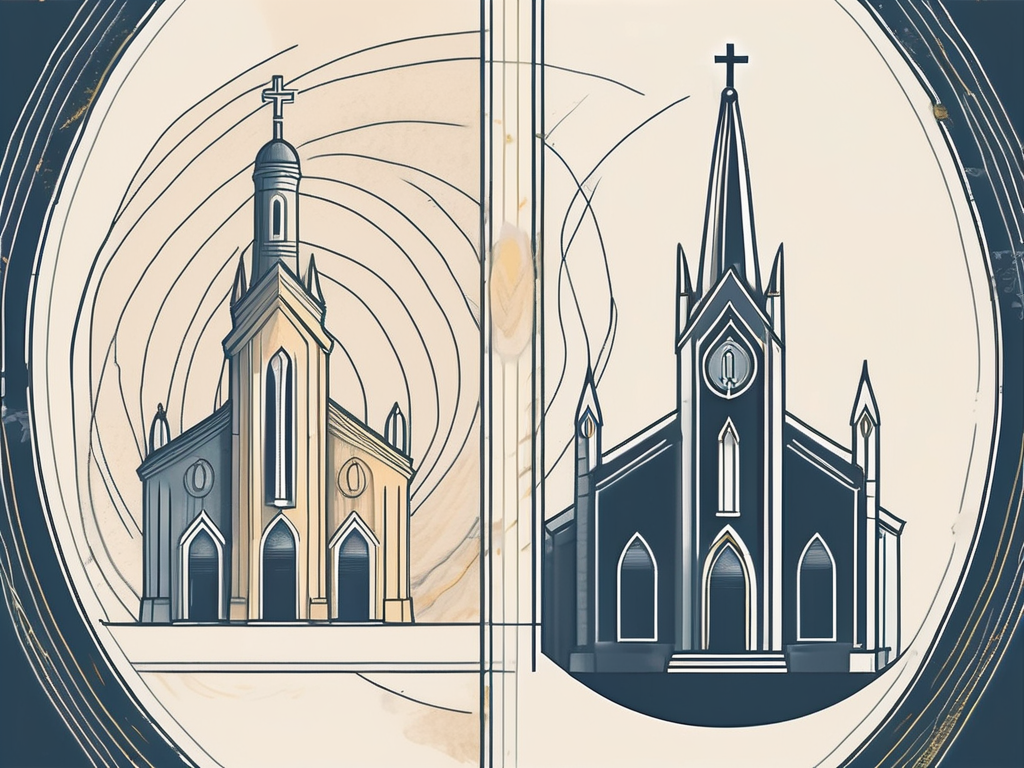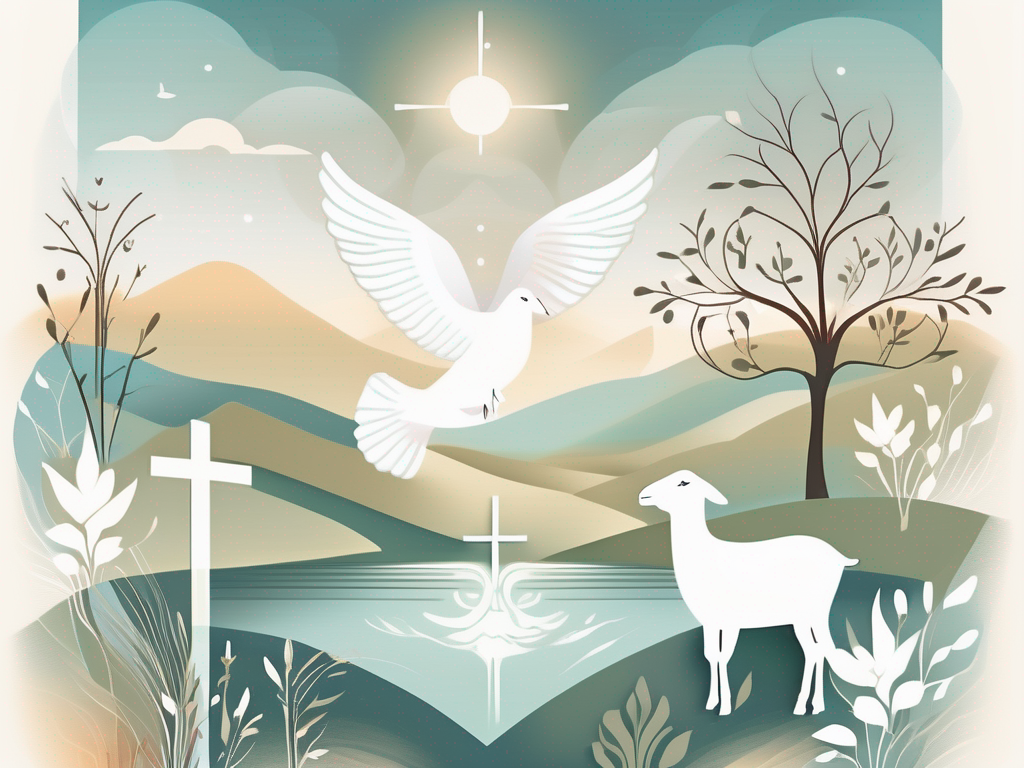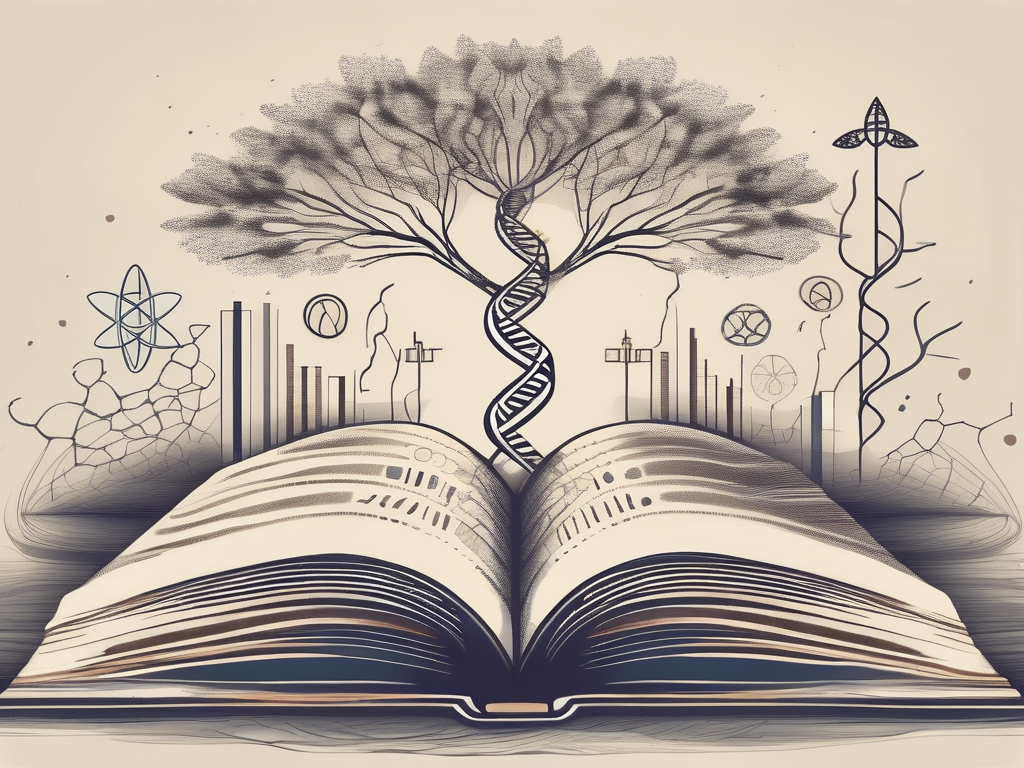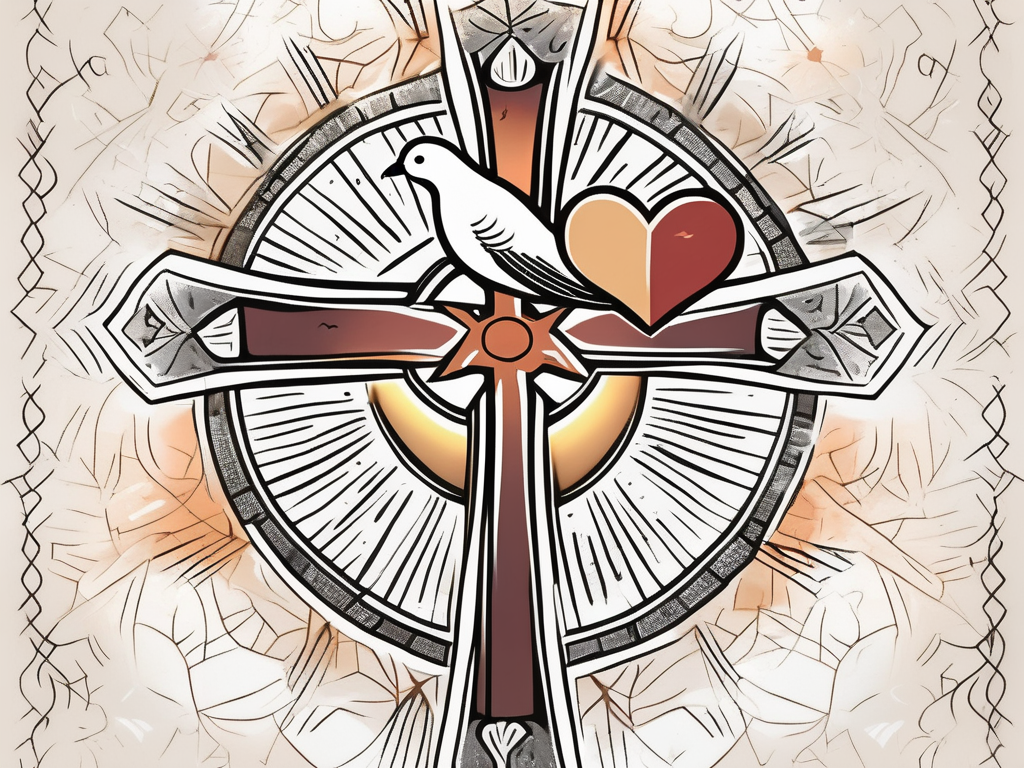Christianity is one of the world’s largest and most influential religions, with billions of followers worldwide. However, many people may not realize that Christianity is not a monolithic entity, but rather is comprised of several distinct branches. In this article, we will explore what these three branches are and what sets them apart. So, let’s dive in and gain a deeper understanding of Christianity!
Understanding Christianity: An Overview
Before delving into the branches of Christianity, it is essential to grasp the origin and evolution of this faith. Christianity traces its roots back to the life and teachings of Jesus Christ in first-century Palestine. Over the centuries, it has undergone transformations and developed distinct beliefs and practices within its various branches.
The Origin and Evolution of Christianity
The early days of Christianity were marked by persecution and resistance as it emerged as a countercultural movement in the Roman Empire. However, its influence gradually grew, and it became the official religion of the empire in the 4th century. This watershed moment paved the way for the diversification of Christianity into three main branches.
These branches are Roman Catholicism, Eastern Orthodoxy, and Protestantism. Each branch has its own unique beliefs, practices, and organizational structures. Let’s explore each one in more detail.
Roman Catholicism
Roman Catholicism is the oldest and largest branch of Christianity, with over a billion followers worldwide. It traces its origins to the early Christian community in Rome and the teachings of Jesus’ apostle, Peter. The Pope, who is considered the successor of Peter, serves as the spiritual leader of the Catholic Church.
Catholicism places a strong emphasis on the sacraments, which are sacred rituals believed to convey God’s grace to the faithful. The seven sacraments include baptism, confirmation, Eucharist, reconciliation, anointing of the sick, holy orders, and matrimony. The Mass, the central act of worship in Catholicism, is a solemn celebration of the Eucharist.
The Catholic Church also upholds the authority of tradition and the Magisterium, which is the teaching authority of the Church. It recognizes the Virgin Mary as the Mother of God and venerates saints as intercessors. The Church’s hierarchical structure includes bishops, priests, and deacons.
Eastern Orthodoxy
Eastern Orthodoxy emerged as a distinct branch of Christianity following the Great Schism of 1054, which divided the Church into the Western (Roman Catholic) and Eastern (Eastern Orthodox) traditions. Eastern Orthodoxy is practiced primarily in Eastern Europe, Russia, and the Middle East.
Orthodox Christians believe in the importance of divine mystery and the mystical experience of God. They emphasize the sacraments, which are seen as transformative encounters with the divine. The Eucharist, known as the Divine Liturgy, is the central act of worship in Eastern Orthodoxy.
The Orthodox Church is governed by a synod of bishops, with the Ecumenical Patriarch of Constantinople considered as the “first among equals.” Icons, sacred images of Christ, the Virgin Mary, and the saints, play a significant role in Orthodox worship and spirituality.
Protestantism
Protestantism emerged in the 16th century as a result of the Protestant Reformation, led by reformers such as Martin Luther, John Calvin, and Huldrych Zwingli. Protestants rejected certain teachings and practices of the Catholic Church and sought to reform and purify Christianity.
Protestantism encompasses a wide range of denominations, including Lutheranism, Calvinism, Anglicanism, Baptism, and Methodism, among others. Each denomination has its own distinct beliefs and practices, but they share common principles such as the authority of Scripture, salvation by faith alone, and the priesthood of all believers.
Protestant worship services vary, but they typically focus on preaching the Word of God, congregational singing, and prayer. Many Protestant denominations reject the veneration of saints and the authority of the Pope, emphasizing the direct relationship between individuals and God.
These three branches of Christianity, Roman Catholicism, Eastern Orthodoxy, and Protestantism, have shaped the religious landscape of the world and continue to influence the lives of millions of people. While they have their differences, they all share a common belief in Jesus Christ as the Son of God and the savior of humanity.
The First Branch: Roman Catholicism
With over 1.3 billion adherents, Roman Catholicism is the largest Christian branch globally. It is characterized by its hierarchical structure, with the Pope serving as its spiritual leader.
The history of Roman Catholicism dates back to the time of Jesus Christ and the establishment of the early Christian Church. As Christianity spread throughout the Roman Empire, the Church grew in influence and power. Over the centuries, the Roman Catholic Church played a significant role in shaping Western civilization, from its involvement in politics to its influence on art, literature, and education.
One of the defining features of Roman Catholicism is its emphasis on tradition and continuity. The Church believes in the apostolic succession, which means that the authority and teachings of the apostles have been passed down through generations, ultimately leading to the Pope as the successor of Saint Peter.
The Beliefs and Practices of Roman Catholicism
Central to Roman Catholicism is the belief in the authority of the Pope and the teachings of the Church. The sacraments, such as baptism and the Eucharist, hold great importance in Catholic worship. These sacraments are seen as visible signs of God’s grace and are believed to bring believers closer to God.
Baptism, the first sacrament, is the initiation into the Christian faith. It is performed by pouring water or immersing the person in water, symbolizing purification and rebirth. The Eucharist, also known as Holy Communion, is the central act of worship in Catholicism. It involves the consumption of bread and wine, which are believed to become the body and blood of Christ.
Additionally, the veneration of saints and the Virgin Mary is a distinctive feature of Roman Catholicism. Saints are seen as holy men and women who have lived exemplary lives and are believed to be in heaven, interceding for the faithful on Earth. The Virgin Mary, as the mother of Jesus, holds a special place in Catholic devotion and is often regarded as the Queen of Heaven.
The Role of the Pope in Roman Catholicism
The Pope, considered the successor of Saint Peter, is regarded as the head of the Church and the Vicar of Christ on Earth. His role involves leadership, spiritual guidance, and the ability to make doctrinal pronouncements that carry authority within the Catholic Church.
The Pope is elected by a conclave of cardinals, who gather in Vatican City to choose the new pontiff. Once elected, the Pope takes on a new name and begins his papacy, serving as the spiritual leader of the Catholic Church. He is responsible for upholding the teachings of the Church, interpreting scripture, and guiding the faithful in matters of faith and morality.
Throughout history, the Pope has played a significant role in shaping the direction of the Catholic Church. From issuing encyclicals on social justice issues to mediating conflicts between nations, the Pope’s influence extends beyond the realm of religion. The Pope’s visits to different countries often draw large crowds of believers, who see his presence as a symbol of unity and hope.
Furthermore, the Pope’s authority is not limited to matters of faith but also extends to matters of doctrine and discipline. He has the power to define dogmas, which are central beliefs of the Catholic Church, and can issue decrees that affect the practices and rituals of Catholics worldwide.
In conclusion, Roman Catholicism is a rich and complex branch of Christianity, with a long history and a strong emphasis on tradition and authority. Its beliefs and practices, centered around the authority of the Pope and the sacraments, have shaped the lives of millions of believers throughout the centuries.
The Second Branch: Eastern Orthodoxy
The second branch of Christianity is Eastern Orthodoxy, which comprises several autocephalous (self-governing) churches. Eastern Orthodoxy is a rich and diverse tradition that has deep historical roots and a unique set of beliefs and practices.
The Beliefs and Practices of Eastern Orthodoxy
Eastern Orthodoxy places great significance on the tradition and continuity of the early Church. It seeks to preserve the teachings and practices of the apostles and the early Christian communities. The church’s liturgical worship is a central aspect of Eastern Orthodoxy, with its elaborate rituals and solemn ceremonies. The use of icons, which are sacred images of Christ, the Virgin Mary, and the saints, is another cherished element within this branch. Icons are seen as windows into the divine and are venerated as a means of connecting with the spiritual realm.
Eastern Orthodoxy also has a strong emphasis on mystical spirituality. The faithful are encouraged to cultivate a personal relationship with God through prayer, meditation, and contemplation. The goal is to experience a direct encounter with the divine and to attain a deep sense of union with God. This mystical approach to spirituality is seen as a path to spiritual growth and transformation.
Maintaining unity with the other Orthodox churches and centers of Orthodoxy is of utmost importance in Eastern Orthodoxy. The Ecumenical Patriarchate of Constantinople, located in modern-day Istanbul, holds a special place in the hearts of Orthodox Christians. It is considered the “first among equals” and serves as a symbol of unity and communion among the various autocephalous churches.
The Role of the Patriarch in Eastern Orthodoxy
While the Pope is the head of the Roman Catholic Church, Eastern Orthodoxy is structured differently. The highest-ranking bishop within each autocephalous church is known as the Patriarch. The Patriarch is responsible for overseeing the spiritual life and administration of the church. They are seen as the spiritual father and leader of their respective church, guiding the faithful in matters of faith, doctrine, and practice.
The role of the Patriarch is not only limited to the internal affairs of the church but also extends to matters of interchurch relations. The Patriarchs play a crucial role in fostering unity and cooperation among the different Orthodox churches. They often serve as mediators and facilitators in resolving disputes and promoting dialogue between churches.
Throughout history, the office of the Patriarch has been held in high regard and has been a symbol of continuity and stability within Eastern Orthodoxy. The Patriarchs are seen as the successors of the apostles and are entrusted with the responsibility of preserving the teachings and traditions of the early Church.
In conclusion, Eastern Orthodoxy is a branch of Christianity that values tradition, liturgical worship, mystical spirituality, and unity among the various autocephalous churches. The role of the Patriarch is central to the functioning of Eastern Orthodoxy, both in terms of overseeing the spiritual life of the church and promoting unity within the Orthodox community.
The Third Branch: Protestantism
The third and final branch we will discuss is Protestantism, which started as a protest or reform movement against certain practices of the Roman Catholic Church in the 16th century.
The Beliefs and Practices of Protestantism
Protestantism emphasizes the authority of the Bible and the individual’s direct relationship with God. The branch encompasses a diverse range of denominations, such as Lutheranism, Reformed Christianity, Anglicanism, and Baptist traditions. Worship styles and practices can vary greatly among these denominations.
The Role of the Pastor in Protestantism
Unlike Catholicism and Orthodoxy, Protestant churches often have a more decentralized structure. Within these churches, the role of the pastor is central. Pastors provide spiritual leadership, deliver sermons, and guide the congregation in matters of faith.
The Differences and Similarities Among the Branches
While the three branches of Christianity diverge on various aspects, they also share common threads as followers of Christ. Doctrinally, specific beliefs like the Trinity and the divinity of Jesus Christ are shared across the branches.
Doctrinal Differences and Similarities
However, there are also significant doctrinal differences among the branches. For example, Roman Catholicism places importance on the authority of the Pope and the Church’s teachings, while Protestantism emphasizes individual interpretation of the Bible.
Worship Styles and Rituals: A Comparison
Another area where the branches differ is in their worship styles and rituals. Roman Catholicism is known for its elaborate liturgical services, whereas Protestant churches tend to have more varied worship styles, including contemporary music and informal settings.
In conclusion, understanding the three branches of Christianity—Roman Catholicism, Eastern Orthodoxy, and Protestantism—is essential in comprehending the diversity within this global faith. Each branch has its own distinct beliefs, practices, and organizational structures that have evolved over centuries. While their differences are significant, it is important to recognize the shared core beliefs that unite Christians around the world. Regardless of the branch one follows, Christianity continues to shape the lives of believers and contribute to the rich tapestry of human spirituality.












